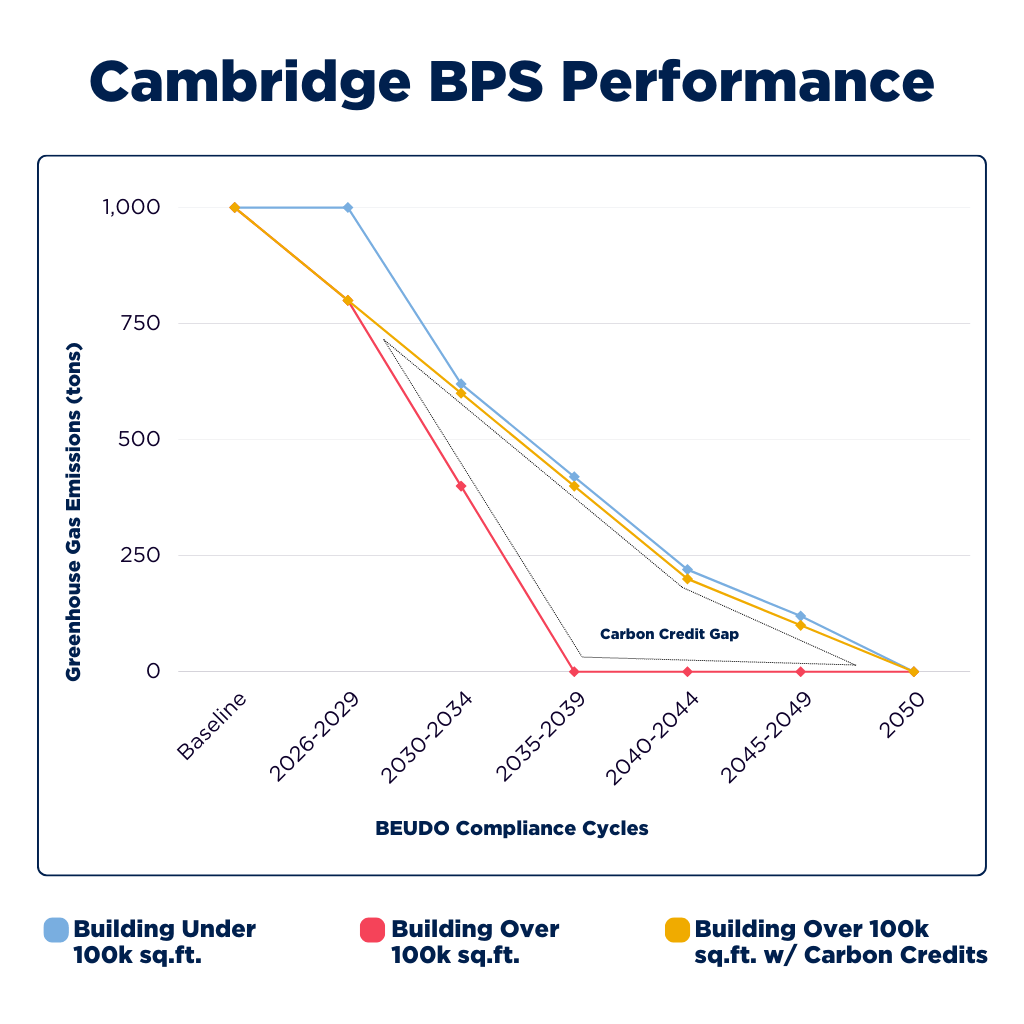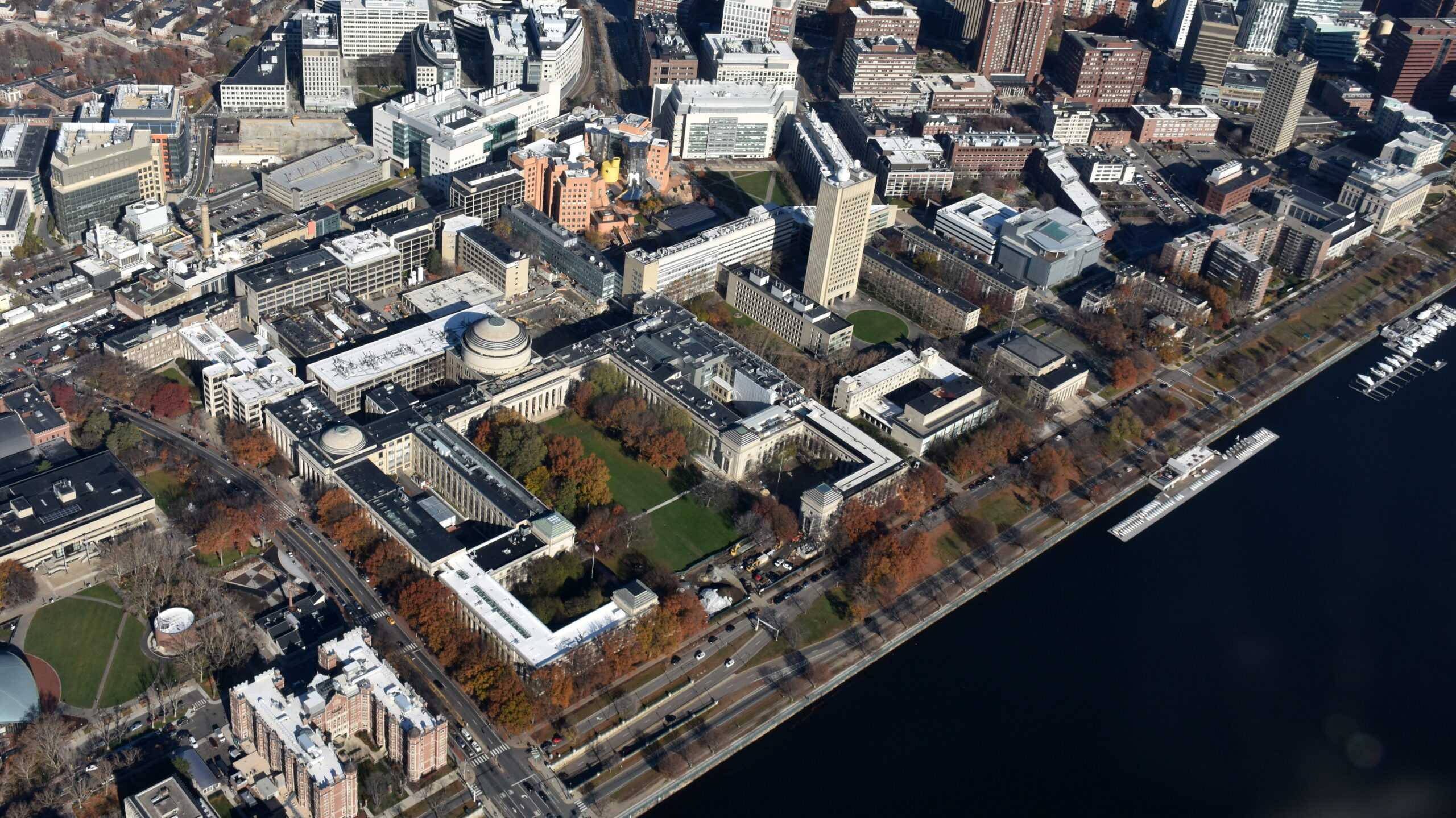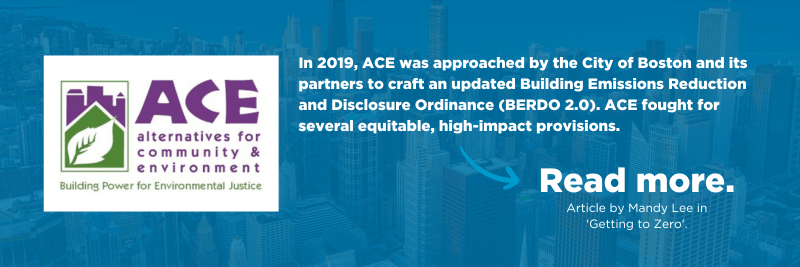
Hey there! Rajiv and James here with your latest building performance standards (BPS) updates. We’re diving into an old, but recently amended law straight out of Massachusetts. We’re geeked to share our fresh perspective. Strap in, grab a lobstah roll, and enjoy our blog.
On June 26th, the City Council of Cambridge, MA approved amendments to the City’s Building Energy Use Disclosure Ordinance (BEUDO). The 2014 law originally focused on the benchmarking and disclosure of building energy performance for commercial, public, and multifamily buildings over 25,000 sq. ft. The ambitious new requirements mandate non-residential buildings to achieve “net-zero greenhouse gas emissions”—2035 for large buildings (more than 100,000 sq. ft.) and 2050 for mid-size buildings (100,000 sq. ft. or smaller). The 2035 requirement is fifteen years ahead of Massachusetts’ commitment to net-zero greenhouse gas (GHG) emissions by 2050. With bold policies like this, and other initiatives outlined in their Net Zero Action Plan, Cambridge is setting itself up as a national climate leader.
At the same time, the city made compromises to achieve the goal of net zero by 2035, and some of these undermine rapid adoption of building efficiency improvements. The extreme ambition of BEUDO’s goals creates challenges for the design and implementation of the policy. Given there is no legal requirement to fully eliminate fossil fuel use before 2050 (let alone 2035!) and large buildings can use carbon credits for the same amount of time, “net-zero greenhouse gas emissions” is a rather toothless promise. Cambridge still has the opportunity to narrow loopholes, and drive decarbonization and divestment through effective rulemaking.
Here’s our initial takeaways from the legislation’s requirements and intentions that can benefit other localities looking to equitably tackle bold emissions reduction targets.
Cambridge’s law allows the use of “Verified Carbon Credits” (aka offsets)
BEUDO permits only the largest buildings (non-residential buildings over 100,000 sq. ft.) to use carbon credits to meet the city’s net-zero targets. Before we get into whether or not carbon offsets are an effective way to achieve climate goals, let’s look at how this could affect the compliance path of a large building.
This table that shows the percentage of the baseline emissions allowance that is available for a carbon credit in each compliance cycle. Now, credit (HA!) where it’s due, Cambridge does taper off these allowances, which is much better than permitting them indefinitely.
This bell curve approach is unusual, and it would have been preferable for these to start at their highest allowance and decrease over time. The 40% offset in 2035-2039 drastically undermines any ability to call this a true net-zero target for large buildings. It also appears at a strange point in the total compliance timeline; after the 40% reduction in emissions that is required 2030-2034.
| Baseline Available For Credit | Compliance Cycle |
| 0% | 2026-2029 |
| 20% | 2030-2034 |
| 40% | 2035-2039 |
| 20% | 2040-2044 |
| 10% | 2045-2049 |
| 0% | 2050 |
Being able to rely on a carbon credit, that is equal to the cut in emissions that is required over the compliance period prior, feels like padding the numbers to ensure Cambridge can claim to have met ambitious targets without truly addressing the issue of reducing onsite emissions. Cambridge could have made a more rigorous policy had they been willing to set an on site net-zero target of 2040.
Let’s see that in theoretical action. In the example below, we have a large building that has a baseline of 1000 tons of GHG emissions per year, in line with the median large office buildings in Cambridge. We compare the tons of emissions per year that the building will be permitted to release with (in green) and without (in yellow) carbon credits. We’ve also charted the compliance trajectory of a building over 25,000, and less than 100,000 sq. ft., with the same baseline emissions

With the use of carbon credits, a building over 100,000 sq. ft. would be able to follow the same emissions targets of smaller buildings from 2035 onwards. The use of carbon credits puts large buildings (which generally produce the most emissions, use the most energy, and have the readiest access to capital) in lock step with buildings that could be as small as a quarter of their size. In fact, the use of credits make it possible for our hypothetical large building to not achieve onsite net-zero emissions until 2050, a target that many other governments have set across the USA. We do need to highlight that this is one model run on a hypothetical scenario, and the facts may be borne out differently in reality. Still, it’s food for thought, innit?
Carbon credits may reduce the intensity at which BEUDO would otherwise have compelled building owners to make efficiency improvements, and there are some broader concerns that should be raised around the carbon credit model.
If we look at the global level, there are stark examples that show carbon credits being used as flagrant greenwashing by companies. When analyzed, 95 million carbon credits, which were sourced in projects that “avoided deforestation” came up short in terms of offsetting emissions (with only 6% of the credits seeing real emission reductions). As in the 2007-2008 global financial crisis, those responsible for certification can succumb to competitive pressure and enforce less demanding standards and as such lower their integrity.
The new law gives Cambridge’s Community Development Department a deadline of December 2028 to write rules around the use of carbon credits. While the best way to avoid critical risks would have been to omit credits entirely, we believe Cambridge may be able to reduce risks by aligning with international best practices around “net-zero-aligned” offsets, including:
- Set rules for offsets that prioritize removing carbon from the atmosphere rather than just avoiding emissions, and ensuring offsets include long-term carbon storage
- Require public disclosure and regular auditing of any offsets used for BEUDO compliance.
BEUDO’s review board
Cambridge has set up an advisory committee, which is similar to the Community Accountability Board (CAB) in IMT’s Model Law for Building Performance Standards. Nine appointed members representing climate advocacy, real estate, and technical fields will be empowered, for example, to approve the types and geographic limits of emissions reduction projects that allow for carbon credits.
With guidance from the Review Board, we hope that Cambridge will ensure that carbon credit projects address frontline community priorities, and that activities generating credits have tangible impacts that benefit Cambridge’s residents. It is concerning that BEUDO does not explicitly invite members from frontline communities, or even require that appointees be residents of the city. Granting real power to a board raises questions about its enforcement capabilities and decision-making authority. If a board’s decisions or recommendations lack legal enforceability, entities being held accountable may choose to ignore or contest them, rendering the board’s power ineffective.
A just BPS > just a BPS
Cambridge must carefully address the equity implications of the BEUDO amendments to ensure that frontline communities and owners of small properties are supported and benefit from the policy.
Upgrading buildings to be net-zero is costly. It is paramount the city designs financial incentives and low-cost financing options alongside its stakeholders to avoid placing an undue burden on already disadvantaged groups. This could involve providing subsidies or tax credits for energy-efficient equipment, very high efficiency (VHE) HVAC installations or other building upgrades. Oh, and there is also this little thing called the Inflation Reduction Act (IRA), which can help provide competitive funding to develop robust incentives and programs. We hope Cambridge is able to build capacity to go after this unprecedented funding as it unfolds over the years. By focusing these incentives on businesses or property owners with limited financial resources, the burden of compliance can be reduced.
While the law aims to reduce emissions, Cambridge must consider its impact on energy affordability for tenants and households. For example, the law encourages lower emissions and more sustainable development. But, building owners facing financial pressures to comply with net-zero requirements may choose to sell properties or convert them into higher-end developments. Such decisions could lead to overinflated property values, increased rents, and displacement of existing residents and local businesses. New housing affordability and anti-displacement measures could protect frontline communities. As Cambridge moves towards rulemaking and implementation, the inclusion of frontline communities in these decision-making processes is key to the City practicing procedural equity.
Vigilance is crucial to mitigate potential harms such as displacement, economic strain on small businesses, and limited access to financing opportunities. Continuous evaluation and adjustment of the policy framework will be vital to ensure that equity remains at the forefront of the law’s implementation. This is an area where the Review Board can be empowered with legal enforceability, in order to realistically work with the City on its implementation strategy. These are just a few examples of equity implications from our initial assessment of the policy, but we cannot stress enough that the Community Development Department carefully addresses these implications, and others, to ensure frontline communities are not further harmed or displaced.
Buckle up universities, now is the time for long-term planning

Cambridge is home to some big ole universities, including two top dogs you’ve heard of—Harvard and the Massachusetts Institute of Technology (MIT). Both are served by legacy district energy systems running on natural gas. Decarbonizing such systems is technologically possible and can even be cost-effective, but it’s a big lift for a number of reasons.
- Scale and Complexity: Universities often have extensive energy infrastructures to support large campuses comprised of research facilities, sports complexes, arts centers, and dormitories. Replacing or retrofitting existing systems to reduce carbon emissions requires careful planning, engineering expertise, and substantial investments. This is typically within reach for these Cambridge-based institutions with sizable endowments and connections to major donors. For smaller schools though, allocating funds to decarbonization initiatives can be challenging, especially when considering the returns on investment and the need to balance immediate needs with sustainability goals! Most of all, it takes time—replacing all district energy piping in a large campus with pipes capable of running on decarbonized energy can take up to a decade.
- Technological Transition: Shifting to low-carbon technologies requires expertise and detailed planning. Even with the allowances provided by carbon offsets, institutions will need to start planning now to transition their campuses in time. Identifying the most appropriate and efficient technologies for a given university’s needs, integrating them into the existing infrastructure, and ensuring compatibility with diverse energy demands is complex.
- Aging Infrastructure: Many universities have older infrastructure that was not designed for optimal energy efficiency or low-carbon operations. Upgrading or replacing outdated equipment will be costly and disruptive. Retrofitting these systems to align with sustainable energy goals may require extensive renovations and potential downtime. BUT, this also creates an opportunity—if the systems will need to be replaced one way or another anyway, decarbonization can even be cost-effective over the equipment lifecycle.
Despite these challenges, universities like Harvard and MIT recognize the importance of reducing emissions and are increasingly committed to decarbonizing their buildings and systems.
Building towards the future
BEUDO is an ambitious policy. Through a robust rulemaking process, Cambridge can improve the odds that compromises like carbon credits will genuinely help the city meet its current and future climate goals. At the same time, Cambridge and its stakeholders must work to ensure that frontline communities have an active hand in the approval of (and benefit from) projects funded by those that have the most wealth, use the most energy, and produce the most emissions.


